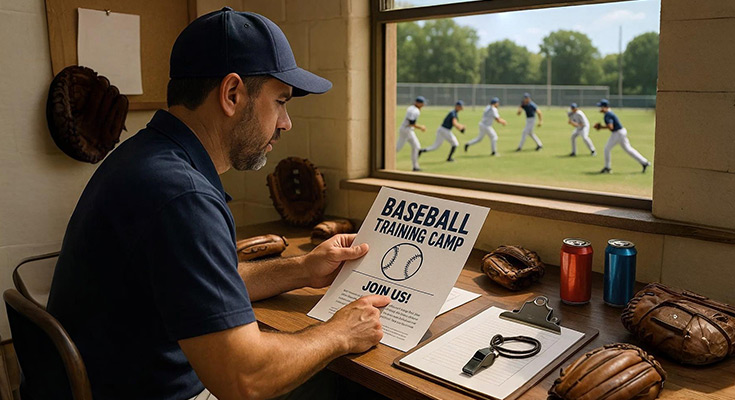The Baseball camps that attract serious young athletes communicate skill development progression, expert coaching credentials, and measurable improvement outcomes through strategic marketing that parents trust and players crave.
Effective baseball flyers combine skill development progression highlighting, coaching credential communication, and safety protocol transparency to attract committed families seeking professional instruction. Successful camp marketing requires age-specific messaging, schedule flexibility communication, and facility showcase strategies that differentiate professional instruction from recreational activities.
This comprehensive guide covers skill development progression frameworks that attract serious athletes and committed parents, coaching credential communication strategies that build trust and demonstrate expertise, and safety protocol transparency that eliminates parent concerns while ensuring enrollment confidence. Strategic baseball training flyers optimize timing, facility showcasing, and age-appropriate messaging to help you create flyers that drive maximum enrollment success.
What Skill Development Progression Should Baseball Camp Flyers Highlight To Attract Serious Young Athletes?
Skill development progression highlighting requires measurable milestone communication, technique improvement tracking, and performance advancement demonstration that shows clear before-and-after outcomes. Effective progression emphasizes fundamental skill mastery, advanced technique development, and competitive preparation that appeals to ambitious young athletes and investment-minded parents seeking tangible improvement results through professional instruction.
Fundamental Skill Foundation Framework
Basic mechanics mastery including hitting fundamentals, throwing technique, and fielding positions creates the foundation for advanced development. Progressive skill building shows advancement from basic competency through intermediate proficiency toward advanced application using measurable benchmarks. Assessment methodology communication demonstrates objective evaluation criteria and progress tracking systems that parents can understand and athletes can visualize.
Research from the National Center for Biotechnology Information emphasizes that effective athletic development programs require “systematic review of educational provision” and structured progression pathways.1 Baseball camp flyers should highlight specific improvements like batting average increases, throwing velocity gains, and fielding error reductions. Fundamental development pathways include stance correction, grip optimization, and footwork enhancement with clear measurement criteria.

Concrete examples include “improve batting contact rate by 25%” or “increase throwing accuracy to 80% strike zone consistency.” These measurable outcomes demonstrate serious development commitment while maintaining achievable expectations for young athletes.
Advanced Technique Development Pathway
Specialized skill enhancement includes advanced hitting approaches like situational batting, pitching development through velocity training, and defensive positioning strategies that separate recreational players from competitive athletes. Position-specific training progression tailored to individual player development goals creates customized pathways for catchers, pitchers, and field position specialists.
Performance metrics integration uses measurable outcomes including exit velocity improvements, pitch accuracy percentages, and defensive reaction time reductions. Advanced techniques like two-strike approaches, pickoff moves, and situational positioning demonstrate sophisticated instruction that serious athletes require for competitive advancement.
Baseball training flyers should emphasize technique refinement that translates to game performance improvements. Examples include “increase fastball velocity by 5-8 mph” or “improve batting average in pressure situations by 30%.” Advanced instruction covers mental game development, strategic thinking, and leadership skills that differentiate competitive players from recreational participants seeking serious athletic development.
Competitive Preparation Outcomes
Game situation application shows how camp skills translate directly to competitive advantage and performance improvement during actual gameplay. College recruitment preparation includes skill development that enhances scholarship opportunities and advancement potential through measurable athletic achievement and competitive performance enhancement.
Tournament readiness demonstration through preparation strategies improves competitive performance and team contribution capabilities. Long-term development planning includes skill progression that extends beyond camp duration, creating lasting improvement foundations for continued athletic growth and competitive success.
The U.S. Department of Health and Human Services’ National Youth Sports Strategy emphasizes that effective youth sports programs should “unite U.S. youth sports culture around a shared vision” and provide “actionable ideas for parents, coaches, organizations, communities, and policymakers to support youth sports participation”.2 This governmental framework supports comprehensive skill development approaches that prepare athletes for competitive advancement.
Baseball camp flyers must communicate specific competitive advantages like “prepare for travel team tryouts” or “develop skills for high school varsity consideration.” Recruitment preparation includes showcasing abilities for scouts, building highlight-worthy performances, and developing competitive confidence through intensive training. Measurable competitive outcomes include improved batting averages during pressure situations, reduced defensive errors in game conditions, and enhanced mental toughness for challenging competitive environments.
Professional instruction methodology demonstration shows systematic approach to skill building that produces consistent, measurable results across different athletic ability levels and competitive aspirations.
Access these specialized baseball camp templates on DesignWiz designed to showcase skill development programs and training progressions.
- Baseball Training Camp Event Flyer
- Spring Baseball Academy Camp Flyer
- Youth Baseball Training Camp Flyer
Read More: Enhance Your Baseball Tournament Promotions with Eye-Catching Flyers
How Do I Communicate Expert Coaching Credentials and Training Methodology in Baseball Camp Flyers?
Expert coaching credential communication requires specific achievement highlighting, methodology explanation, and experience demonstration that builds parent confidence and athlete excitement. Effective credential presentation emphasizes playing background, coaching certifications, and teaching success stories that differentiate professional instruction from amateur alternatives. Baseball camp flyers must showcase tangible coaching accomplishments while explaining instructional approaches that produce measurable player improvement.
Professional Background Presentation
Professional playing experience creates immediate credibility through college, semi-professional, or professional achievements that demonstrate high-level baseball understanding. Display specific accomplishments like conference championships, statistical achievements, or professional organization affiliations. Coaching certifications from recognized organizations like USA Baseball, NFCA, or ABCA validate formal training and continuing education commitment.
Success stories featuring previous player development outcomes establish proven instruction effectiveness. Include specific examples like players advancing to high school varsity, college recruitment, or scholarship achievements under your coaching guidance. Quantify results with improvement statistics, team achievements, or individual player advancement rates that demonstrate tangible coaching impact.
Professional affiliations with baseball organizations, ongoing education participation, and clinic attendance show commitment to current best practices and continuous improvement. Mention relationships with college coaches, professional scouts, or established baseball programs that provide credibility and potential player exposure opportunities.
Highlight your coaching expertise with these professional baseball camp templates on DesignWiz that emphasize instructor credentials and experience.
- Baseball Club Coaching Recruitment Flyer
- Youth Baseball Coaching Staff Introduction Flyer
- Baseball Coaches Wanted Flyer
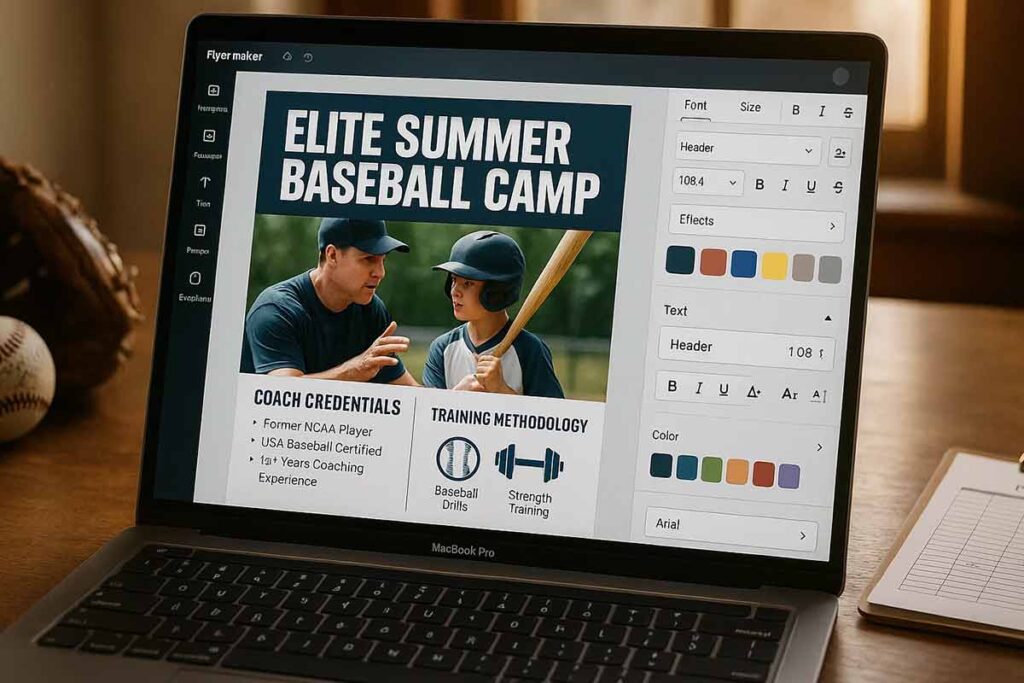
Teaching Methodology Explanation
Instructional approach description should explain specific techniques, learning theories, and skill development strategies that distinguish professional coaching from recreational instruction.3 Detail how you break down complex skills into teachable components, use video analysis for technique improvement, and implement progressive skill-building sequences.
Individual attention emphasis demonstrates personalized instruction commitment through customized development approaches for different skill levels and learning styles. Explain assessment procedures used to identify individual player needs and create targeted improvement plans that address specific weaknesses while building on strengths.
Progress tracking methodology explains evaluation systems and improvement measurement techniques that provide objective feedback to players and parents. Detail how you document skill development, use performance metrics to track advancement, and communicate progress through regular updates and assessment reports that justify program investment and demonstrate professional instruction standards.
Expertise Differentiation Strategy
Specialized knowledge demonstration separates professional coaching from amateur instruction through advanced techniques, cutting-edge training methods, and innovative instruction approaches that reflect current baseball development trends. Highlight expertise in specific areas like hitting mechanics, pitching development, or defensive positioning that addresses common player development challenges.
Professional development commitment shows ongoing education through coaching clinics, certification renewals, and industry involvement that maintains current best practice implementation. Mention recent training attended, new methodologies learned, and connections with other professional coaches that ensure instruction quality stays current with baseball development evolution.
Mentor network integration features connections with high-level coaches, former professional players, and development experts who provide advanced instruction opportunities and potential player exposure. Detail relationships with college coaches who provide recruitment insights, professional players who offer specialized instruction, or established programs that create advancement pathways for dedicated players.
Results-based validation uses testimonials, success metrics, and improvement documentation that proves instructional effectiveness through measurable outcomes. Include parent testimonials highlighting player development, statistical improvement documentation, and advancement success stories that demonstrate how professional coaching translates to tangible player achievement and competitive advantage development.
What Camp Schedule Flexibility Accommodates Working Parents While Maximizing Training Effectiveness?
Schedule flexibility optimization requires multiple session options, extended hour availability, and pickup coordination that accommodates working parent schedules while maintaining intensive training quality. Effective scheduling balances convenience accessibility with instruction effectiveness through strategic timing and comprehensive coverage options. Successful baseball camp flyers must communicate flexibility without compromising training standards, creating appealing options for busy families seeking professional instruction.
Multiple Session Option Framework
Half-day and full-day programs provide schedule choice while maintaining intensive instruction quality through concentrated skill development blocks. Morning sessions (8 AM-12 PM) attract early-drop families, while afternoon blocks (1 PM-5 PM) accommodate different parent schedules. Drop-in session availability allows flexible participation without full commitment requirements, perfect for families testing program quality before extended enrollment.
Extended care options including early drop-off (7 AM) and late pickup (6 PM) accommodate working parent convenience without diluting core instruction time. Sessions maintain skill-building intensity through focused 2-3 hour training blocks rather than stretched all-day programs that reduce effectiveness.
Weekend intensive options provide concentrated training for families preferring non-weekday participation. Multiple weekly schedule combinations allow families to choose 2-day, 3-day, or 5-day options based on availability and budget constraints while ensuring consistent skill development progression.
Communicate flexible scheduling options using these versatile baseball camp templates on DesignWiz tailored for working parent convenience.
- Baseball Team Schedule Announcement Flyer
- Fall Baseball Tournament Schedule Flyer
- Team Baseball Roster Announcement Flyer
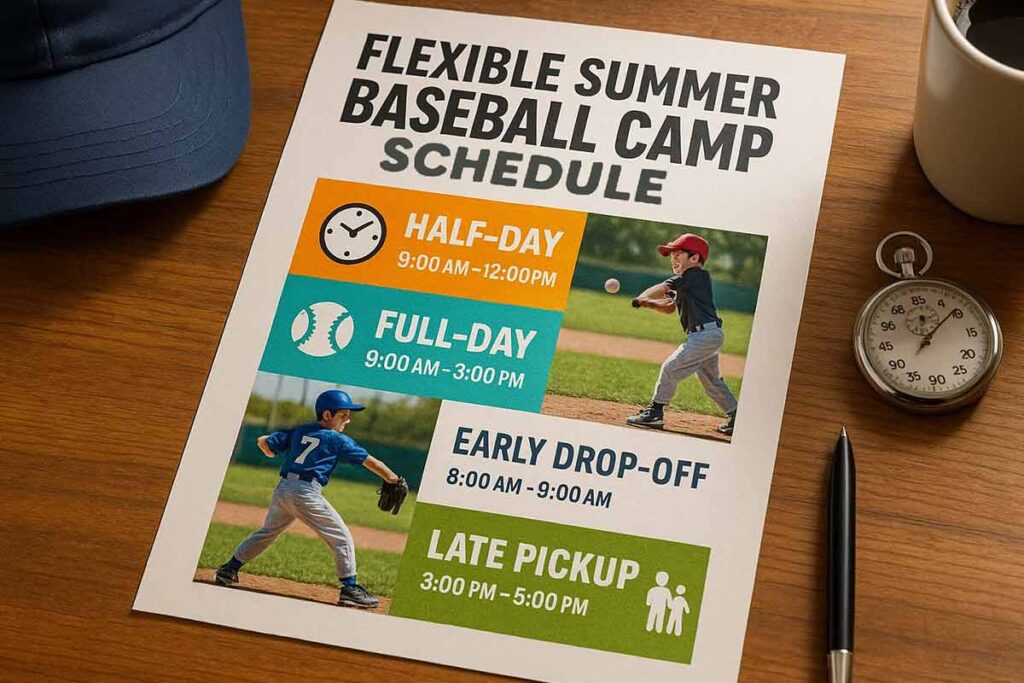
Working Parent Accommodation Strategy
Transportation coordination including pickup/drop-off assistance and carpooling facilitation eliminates logistical barriers for working families. Communication system integration provides regular updates and progress reports throughout camp duration, allowing parents to stay informed despite work schedules. Text messaging updates and photo sharing keep parents connected to their child’s development.
Emergency contact protocols ensure reliable communication and safety coverage during extended hours. Flexible payment plans accommodate family budgets while early registration discounts reward advance planning. Baseball training flyers effectively communicate these accommodations through clear scheduling grids and contact information prominence.
Lunch provision options eliminate meal planning concerns for full-day participants. Extended supervision during pickup windows prevents rushed departures while maintaining safety standards. Partnership coordination with local schools and childcare providers creates seamless transitions for comprehensive family scheduling solutions.
Training Effectiveness Preservation
Intensive instruction maintenance despite schedule flexibility occurs through efficient session design and focused skill development blocks. Quality assurance protocols ensure consistent instruction standards across different session options and timing alternatives. Small instructor-to-participant ratios preserve individual attention regardless of schedule variation.
Progress continuity systems maintain development momentum regardless of attendance pattern through individualized tracking and makeup session availability. Skill-building modules allow partial participants to complete development sequences without compromising learning progression. Assessment checkpoints ensure all participants meet advancement criteria regardless of scheduling choice.
Specialized coaching assignment ensures experienced instructors handle flexible scheduling challenges while maintaining instruction quality. Equipment availability remains consistent across all session times, preventing resource limitations that could impact training effectiveness. Performance measurement standards apply equally to all schedule options, ensuring development outcomes remain uncompromised.
Strategic session sequencing builds skills progressively even with attendance variations. Recording systems track individual progress across different attendance patterns, allowing coaches to customize instruction based on participation history. Makeup protocols ensure missed critical instruction components receive individual attention, maintaining program effectiveness while accommodating family scheduling needs.
How Can I Showcase Advanced Facilities and Equipment in Baseball Training Flyer Marketing?
Advanced facility showcasing requires specific equipment highlighting, technology integration demonstration, and professional environment presentation that justifies premium pricing and attracts serious development seekers. Effective facility marketing emphasizes competitive advantages and training enhancement capabilities that differentiate professional instruction from basic alternatives. Baseball camp flyers must communicate how advanced facilities directly translate to superior instruction outcomes and measurable improvement acceleration.
Equipment Advantage Communication
Cutting-edge technology integration including radar guns, video analysis systems, and performance tracking equipment creates measurable training advantages that parents and players recognize. Professional-grade facility features showing regulation batting cages, pitcher’s mounds with proper dimensions, and field conditions that mirror competitive environments demonstrate serious commitment to authentic development. Safety equipment prominence featuring comprehensive protective gear, medical support stations, and emergency preparedness systems eliminates parent concerns while showcasing professional operation standards.
Showcase your premium training facilities with these impressive baseball camp templates on DesignWiz that highlight advanced equipment and technology.
- Youth Baseball Training Academy Flyer
- Baseball Training Camp Event Flyer
- Spring Baseball Academy Camp Flyer
Professional Environment Presentation
Facility tour integration through high-quality photography, virtual tour capabilities, and detailed feature descriptions allows families to experience professional atmosphere before enrollment commitment. Competitive comparison highlighting advantages over alternative facilities and training environments positions your camp as premium development option worth investment consideration. Maintenance standards communication showing commitment to quality upkeep, safety protocols, and professional appearance builds confidence in operational excellence.
Visual documentation of field conditions, equipment maintenance, and facility cleanliness demonstrates ongoing investment in player development infrastructure that justifies premium pricing structures.
Training Enhancement Demonstration
Technology-assisted instruction showing how advanced equipment enhances learning acceleration and improvement measurement provides concrete value demonstration that appeals to investment-minded parents. Performance analysis capability featuring data collection systems, progress tracking technology, and objective improvement documentation creates transparent development monitoring that builds trust and demonstrates results. Professional atmosphere creation through facility presentation inspires serious development commitment and high performance expectations that attract dedicated athletes.
Investment justification explaining how superior facilities translate to accelerated improvement outcomes and competitive advantage development helps parents understand value proposition.
Professional facility showcase strategies must balance impressive equipment presentation with practical training benefit communication. Advanced facilities justify premium pricing through demonstrated competitive advantages, technology-enhanced instruction, and measurable improvement acceleration that basic training environments cannot provide.
Read more: Baseball Flyer Budget Solutions: Cost Optimization & Resource Efficiency
What age-specific camp messaging appeals to different developmental stages (8-12, 13-16, 17+)?
Age-specific messaging optimization requires developmental psychology understanding, skill-appropriate communication, and age-relevant motivation strategies that resonate with different maturity levels and baseball experience stages. Research emphasizes that appropriate practice and content should take into account athlete developmental stage and skills, with parental support focusing on development and fun instead of winning emerging as a key factor in athlete enjoyment (American Academy of Pediatrics).4
Effective baseball flyers differentiate messaging for elementary players focused on fun skill building, middle schoolers seeking competitive preparation, and high school athletes pursuing college recruitment opportunities. Successful age targeting balances developmental appropriateness with challenge inspiration while addressing parent concerns and player motivations specific to each group’s psychological and social development needs.
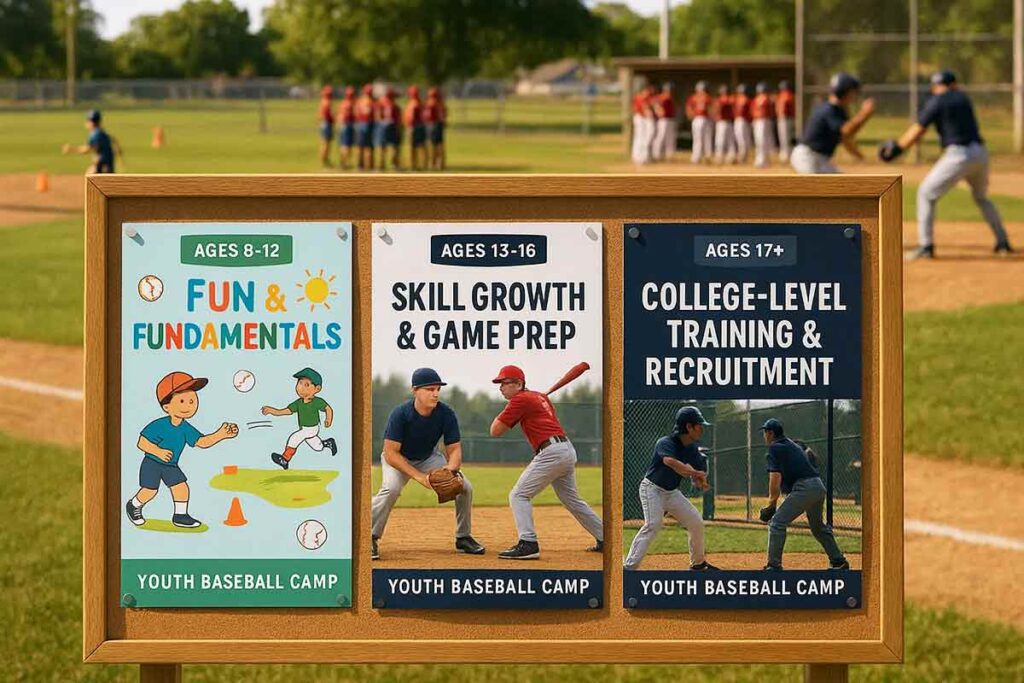
Elementary Age Group (8-12) Messaging Strategy
Elementary age messaging emphasizes fun-centered skill development through game-based learning approaches that build fundamental baseball competencies while maintaining high engagement. Marketing materials should highlight enjoyable instruction methods, positive coaching environments, and basic skill mastery achievements that build confidence and athletic foundation. Parents respond to safety assurances, skill development progression, and social interaction benefits that create positive baseball experiences.
Effective messaging includes colorful visual elements, action photography featuring young players, and simple language describing camp activities and learning outcomes. Systematic reviews demonstrate specific psychological and social health benefits of sport participation for children, with the most commonly reported benefits being improved self-esteem, social interaction, and fewer depressive symptoms, supporting the importance of positive development environments. Emphasize character development, teamwork benefits, and fundamental skill building rather than competitive pressure or advanced technique development.5 Parent communication should address supervision quality, age-appropriate instruction methods, and positive experience guarantees that eliminate concerns about pressure or negative coaching approaches.
Marketing materials should showcase beginner-friendly equipment, modified game formats, and achievement recognition systems that celebrate effort and improvement rather than elite performance. Include testimonials from parents highlighting fun experiences and skill improvement rather than competitive achievements.
Engage young players and parents with these fun, colorful baseball camp flyers on DesignWiz designed specifically for elementary-age participants.
- Youth Baseball Camp Promotional Flyer
- Community Baseball Field Event Promotion Flyer
- Youth Baseball Camp Event Flyer
Middle School Age Group (13-16) Messaging Strategy
Middle school messaging balances competitive preparation with social development benefits, addressing increased performance awareness while maintaining positive development focus. Camp materials should emphasize advanced skill development, team interaction opportunities, and preparation for high school baseball participation. Players seek challenge and improvement while parents value competitive readiness and positive peer relationships.
Effective communication highlights technique refinement, position-specific training, and measurable improvement outcomes that prepare players for school team tryouts and travel baseball participation. Social aspects including friendship development, team building activities, and positive competitive environment should feature prominently in messaging approaches.
Marketing materials should include player progression stories, advanced skill development methodologies, and preparation for competitive baseball environments. Address parent concerns about appropriate challenge levels, positive coaching approaches, and college preparation benefits without creating unrealistic advancement expectations or excessive pressure.
Appeal to competitive middle schoolers with these dynamic baseball camp flyers on DesignWiz that balance skill development with social benefits.
- Dynamic Red Sports Baseball Training Camp Flyer
- Colorful Youth Baseball Summer Camp Registration Flyer
- Baseball Club Tryouts Announcement Flyer
Read More: Baseball Tryout Flyers: Complete Player Selection & Evaluation Process Guide
High School Age Group (17+) Messaging Strategy
High school messaging focuses on college recruitment preparation, elite skill development, and competitive advantage building through professional-level instruction and performance enhancement. Marketing emphasizes serious development commitment, measurable improvement outcomes, and advancement opportunities that justify intensive training investment. Players and parents seek concrete results and competitive preparation rather than recreational benefits.
Effective messaging includes college recruitment statistics, advanced training methodologies, and performance measurement systems that demonstrate objective improvement. Highlight coaching credentials, professional connections, and success stories featuring college placement and scholarship achievements from previous participants.
Communication should address individual skill assessment, personalized development planning, and competitive preparation strategies that enhance college recruitment prospects. Include specific performance metrics, video analysis capabilities, and professional-level training equipment that differentiate elite instruction from recreational programs.
Marketing materials should feature testimonials from college-bound players, recruitment success stories, and specific improvement documentation that validates intensive training investment. Address serious development commitment expectations while showcasing elite instruction quality and competitive advantage benefits that justify premium pricing and time investment.
Attract serious high school athletes with these elite baseball camp flyers on DesignWiz focused on college recruitment and advanced training.
- Baseball Club Promotional Event Flyer
- Baseball Themed Graduation Party Flyer
- Youth Baseball Sign-up Registration Flyer
Read More: Baseball Youth Programs Flyer: Complete Teen Development & High School Preparation Strategy
How Do I Balance Fun Camp Atmosphere With Serious Skill Development in Baseball Camp Flyers?
Balancing fun atmosphere with serious skill development requires strategic messaging that emphasizes enjoyable learning, positive challenge, and achievement celebration while maintaining improvement commitment. Effective balance communication shows how fun enhances learning rather than competing with development goals through game-based instruction and professional coaching that creates both skill advancement and positive memories.
Enjoyable Learning Framework
Game-based instruction integration demonstrates how fun activities enhance skill acquisition and retention while building fundamental baseball competencies. Effective baseball camp flyers showcase drills disguised as games, competitive team challenges, and skill-building activities that maintain engagement without sacrificing instruction quality.
Positive coaching atmosphere communication features encouragement, support, and confidence building approaches that create safe learning environments. Professional coaches understand that young athletes perform better when instruction feels supportive rather than demanding. Baseball training flyers should highlight coaching philosophy emphasizing growth mindset development and individual progress recognition.
Achievement celebration emphasis includes recognition systems and milestone acknowledgment that maintain motivation throughout intensive training periods. Successful camps create multiple opportunities for players to experience success through skill badges, improvement certificates, and peer recognition programs. This celebration culture reinforces serious development while preserving enjoyment and enthusiasm for continued learning.

Serious Development Commitment
Measurable improvement emphasis shows objective progress tracking and skill development documentation that demonstrates professional instruction standards. Baseball camp flyers must communicate specific assessment methods, improvement benchmarks, and progress reporting systems that assure parents their investment produces tangible results.
Professional instruction standards maintain high expectations while preserving positive atmosphere through structured learning progressions and expert coaching methodologies. Quality camps balance challenge with support by setting appropriate difficulty levels that inspire growth without creating frustration or discouragement among developing players.
Challenge acceptance culture features appropriate difficulty levels that inspire growth while maintaining positive learning environments. Effective baseball training flyers emphasize how coaches create individualized challenges that push each player toward improvement while ensuring success experiences that build confidence and maintain engagement throughout the intensive development process.
Competitive Excellence Culture
High performance expectation communication shows commitment to excellence without pressure or negativity through positive reinforcement and achievement-focused messaging. Baseball camp flyers should emphasize competitive preparation while highlighting supportive coaching approaches that help players reach their potential without creating anxiety or performance pressure.
Team culture development emphasizes mutual support, positive competition, and collective improvement that creates inspiring environments where individual excellence contributes to group success. Successful camps foster peer encouragement and collaborative learning that enhances individual development through group dynamics.
Success mindset cultivation through mental training, confidence building, and resilience development creates lasting improvement beyond technical skill enhancement. Professional baseball instruction includes mental game development, goal setting, and positive self-talk training that produces confident, resilient players who enjoy competition while pursuing excellence.
Parent satisfaction assurance shows how balanced approach produces both skill improvement and positive experience memories that justify investment while creating enthusiasm for continued baseball participation. Baseball camp flyers should communicate how fun and development work together to create comprehensive athletic growth that extends beyond camp duration.
What Safety Protocols and Insurance Coverage Should Baseball Camp Flyers Prominently Feature?
Safety protocol prominence requires specific procedure communication, insurance coverage transparency, and emergency preparedness demonstration that eliminates parent concerns and ensures enrollment confidence. Effective safety marketing balances comprehensive protection with approachable presentation that builds trust without creating anxiety. Baseball camp flyers must showcase professional risk management while maintaining the fun, engaging atmosphere that attracts young athletes and reassures families about program quality and participant protection.
Comprehensive Safety Procedure Framework
Medical emergency protocols include first aid availability, emergency contact systems, and hospital coordination procedures that ensure immediate response capabilities. Equipment safety standards feature protective gear requirements, equipment inspection schedules, and injury prevention measures that minimize accident risks during intensive training sessions. Facility safety maintenance encompasses field condition monitoring, hazard elimination protocols, and environmental safety assurance through regular inspections and proactive maintenance schedules.
Weather contingency planning addresses severe weather protocols, facility evacuation procedures, and participant protection measures during storms or dangerous conditions. Staff safety training includes CPR certification requirements, emergency response procedures, and ongoing safety education that maintains professional response capabilities. Communication protocols establish clear parent notification systems during emergencies and regular safety updates throughout camp duration.
Insurance Coverage Transparency
Liability coverage communication includes comprehensive protection details and coverage scope explanation that addresses parent concerns about potential accidents or injuries. Participant protection emphasis showcases medical coverage options, accident insurance availability, and family protection measures that provide financial security during unforeseen incidents. Property insurance demonstration features facility protection coverage and comprehensive risk management that protects both participants and camp operations.
Professional indemnity coverage addresses coaching liability, instructional safety, and professional responsibility insurance that protects families and demonstrates commitment to qualified instruction. Equipment insurance explains coverage for participant belongings, facility equipment protection, and replacement policies for damaged or lost items during camp activities.
Emergency Preparedness System
Staff training certification requires current first aid credentials, CPR qualification maintenance, and emergency response training that ensures qualified medical response capabilities. Every staff member maintains updated certifications and participates in regular emergency drill practice sessions.
Communication protocol establishment features immediate parent notification systems, emergency contact procedures, and real-time update capabilities during crisis situations. Multiple communication channels ensure reliable contact regardless of circumstances, including text messaging, phone calls, and email notifications for comprehensive family coordination.
Professional medical partnerships demonstrate relationships with local healthcare providers, immediate response coordination, and established protocols for serious injury management. These partnerships include nearby hospitals, sports medicine clinics, and emergency medical services that provide rapid professional care when needed.
Facility emergency equipment includes automated external defibrillators, comprehensive first aid supplies, and emergency communication devices positioned throughout camp areas. Regular equipment maintenance schedules ensure all emergency tools remain functional and accessible during critical situations.
Evacuation procedures address multiple emergency scenarios including severe weather, facility emergencies, and security concerns. Clear evacuation routes, designated meeting areas, and participant accountability systems ensure organized response during any emergency situation requiring facility evacuation.
Documentation protocols maintain detailed incident reports, medical information access, and emergency contact verification that supports professional response and provides families with comprehensive incident management and follow-up care coordination.
Read more: Little League Baseball Flyers: Complete Youth Program Marketing Guide
How Can I Optimize Baseball Camp Flyer Timing For Maximum Enrollment and Early Bird Registration?
Timing optimization requires seasonal marketing strategy, early registration incentive communication, and enrollment deadline management that maximizes participation while allowing adequate planning time. Effective timing balances urgency creation with family decision-making accommodation through strategic announcement schedules and incentive structures that attract committed participants.
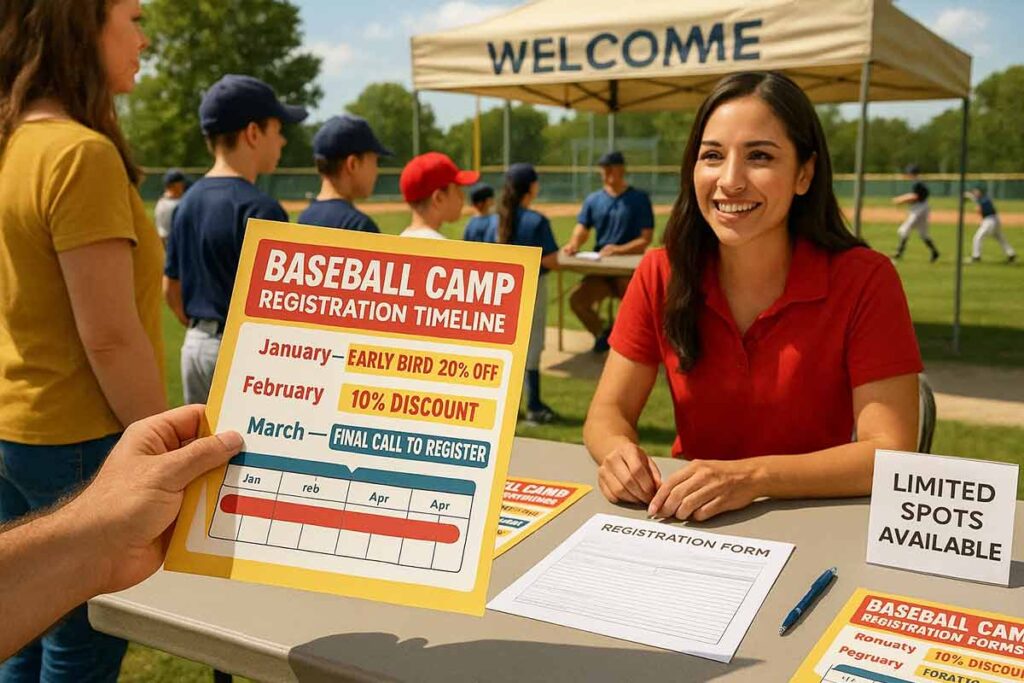
Seasonal Marketing Timeline Strategy
Launch baseball camp flyers during optimal decision windows when families actively plan summer activities. Begin initial announcements in January when parents research summer programs, followed by intensive marketing from February through April when registration decisions peak. Target early February for maximum impact, avoiding holiday distractions while capturing New Year planning momentum.
Spring break timing creates crucial registration windows as families finalize summer schedules. Position major marketing pushes two weeks before and after spring break periods, accounting for varying school district calendars. March represents peak enrollment activity when parents balance multiple program options and make final commitments.
Competition awareness requires strategic timing that avoids oversaturation periods. Monitor local program announcements and position flyer distribution during quieter marketing windows. Early announcement advantages capture serious families before alternative programs flood the market with competing messages.
Early Registration Incentive Framework
Structure early bird discounts using tiered deadlines that reward prompt decision-making without devaluing program quality. Implement 15-20% early registration discounts for January commitments, followed by 10% discounts through February, and 5% discounts until final deadlines.
Limited capacity emphasis creates appropriate urgency without pressure tactics. Communicate specific enrollment limits and current registration numbers to demonstrate demand while encouraging timely decisions. Include waitlist availability for programs reaching capacity, showing continued interest accommodation.
Payment plan integration removes financial barriers for early commitment. Offer installment options exclusively for early registrants, creating additional incentive value beyond simple discount structures. Bonus benefits like equipment packages or extra training sessions reward early registration with tangible value additions.
Enrollment Management Strategy
Deadline communication requires careful balance between urgency creation and family accommodation. Establish firm registration deadlines four weeks before camp start dates, allowing adequate planning time while creating decision pressure. Include countdown elements in marketing materials without overwhelming busy parents with excessive urgency messaging.
Waitlist management demonstrates program quality through demand indication. Maintain active waitlists even after capacity, communicating with interested families about potential openings and future program availability. This strategy builds long-term relationships while indicating program desirability to prospective families.
Follow-up sequence optimization maximizes conversion from interested prospects. Implement strategic reminder communications at two-week intervals, highlighting program benefits and approaching deadlines without becoming intrusive. Include testimonials and success stories that reinforce value propositions during decision periods.
Capacity planning transparency protects program quality while managing expectations. Communicate participant limits clearly, explaining how restrictions ensure individual attention and instruction quality. This approach attracts quality-focused families while justifying premium pricing through exclusive positioning.
Strategic reminder timing captures last-minute decision makers without appearing desperate. Send final opportunity communications one week before deadlines, emphasizing limited remaining spots and program benefits.
Read more: Baseball Tournament Flyers: Complete Competition Event Promotion Guide
People Also Ask: Camp Instruction Implementation Questions
1. What camp duration options attract the most serious young baseball players?
Week-long intensive camps attract committed development seekers while single-day clinics accommodate casual participants. Multi-week programs build deeper skills but require greater commitment.
2. Should baseball camp flyers emphasize individual skill development or team dynamics?
Individual improvement attracts serious players and investment-minded parents while team dynamics appeal to social development seekers. Combine both for broader appeal.
3. How much coaching staff information should training camp flyers include?
Include key credentials, playing background, and teaching experience for head coaches. Brief staff overviews build confidence without overwhelming design space.
4. What camp pricing transparency builds enrollment confidence without deterring budget-conscious families?
List base pricing clearly with payment plan options. Mention scholarship availability without detailed qualification requirements. Transparency builds trust while flexibility attracts diverse families.
5. Should intensive training camp flyers mention specific skill improvement guarantees?
Promise effort-based improvement rather than specific performance outcomes. Emphasize professional instruction commitment and measurable progress tracking without unrealistic guarantees.
6. How do specialized camp flyers differentiate from general youth baseball programs?
Highlight advanced instruction methods, professional coaching credentials, and intensive development focus. Emphasize serious improvement commitment versus recreational participation.
7. What camp atmosphere communication attracts committed families while filtering casual interest?
Balance fun emphasis with serious development messaging. Professional atmosphere descriptions attract committed families while maintaining approachable appeal for young athletes.
8. How much technical baseball instruction detail should camp flyers include?
Provide enough methodology description to demonstrate expertise without overwhelming non-technical parents. Focus on outcomes and improvement benefits rather than complex techniques.
FAQs: Professional Camp Marketing Implementation
1. What camp registration process information should baseball training flyers include?
Include registration deadlines, required documents, payment options, and contact info. Mention medical forms, emergency contacts, equipment needs, online registration links, and office hours. Clear details ease enrollment and build parent trust.
2. How do baseball camp flyers address varying skill levels within age groups?
Highlight skill-based grouping, individual assessments, and tailored development plans. Focus on ability over age to ensure appropriate challenges for all.
3. What camp cancellation and refund policies should training flyers communicate?
Mention weather cancellations, refund timelines, makeup sessions, and emergency protocols. Transparency builds confidence and protects both families and the program.
4. Should baseball camp flyers mention college recruitment exposure opportunities?
Include recruitment info for high school-level camps only. Prioritize development benefits over unrealistic promises to set clear expectations.
5. How do training camp flyers communicate nutritional and meal planning for extended programs?
Share meal details, dietary accommodations, snack needs, hydration protocols, and allergy handling. Clear info shows care and professionalism.
6. What transportation and pickup coordination should baseball camp flyers address?
Provide pickup/drop-off times, parking info, carpool options, late pickup policies, and emergency contact details. This helps parents plan smoothly.
7. How much equipment requirement detail should training camp flyers provide?
List required and provided gear, rental options, and safety standards. Clear equipment info ensures preparedness and avoids registration delays.
8. What camp atmosphere balance appeals to both competitive and recreational participants?
Promote a fun yet focused environment with skill development, positive coaching, and achievement recognition to attract all player types.
9. Should baseball camp flyers include specific coach-to-participant ratios?
Yes, highlight low ratios, specialized coaching, and staff qualifications to show instruction quality and justify pricing.
10. How do training camp flyers handle different experience levels and skill development paths?
Focus on customized instruction, group placement by skill, and progress tracking to support players at every development stage.
Conclusion
Effective baseball camp flyers build trust and attract serious athletes by clearly communicating coaching credentials, skill development plans, and advanced training methods. Highlighting measurable progress benchmarks, expert instruction, and personalized attention reassures parents about quality while distinguishing the camp from recreational options.
Additionally, showcasing professional-grade facilities, safety protocols, and age-specific messaging helps connect with families across all developmental stages. When combined with transparent schedules and competitive preparation, this approach positions the camp as a credible, high-value opportunity for young athletes seeking growth and advancement. Using well-designed flyer templates can simplify this process, helping you present your camp professionally and attract the right participants.
Reference
- Optimising long-term athletic development: An investigation of practitioners’ knowledge, adherence, practices and challenges. PMC. National Center for Biotechnology Information.
- About the National Youth Sports Strategy. Office of Disease Prevention and Health Promotion. U.S. Department of Health and Human Services.
- SAFETY Clinic Course – Sports Awareness For Educating Today’s Youth.” Rutgers University. Rutgers Youth Sports Research Council.
- “Organized Sports for Children, Preadolescents, and Adolescents.” American Academy of Pediatrics (2019).
- “Psychological and social benefits of participation in sport for children and adolescents.” International Journal of Behavioral Nutrition and Physical Activity (2013).
